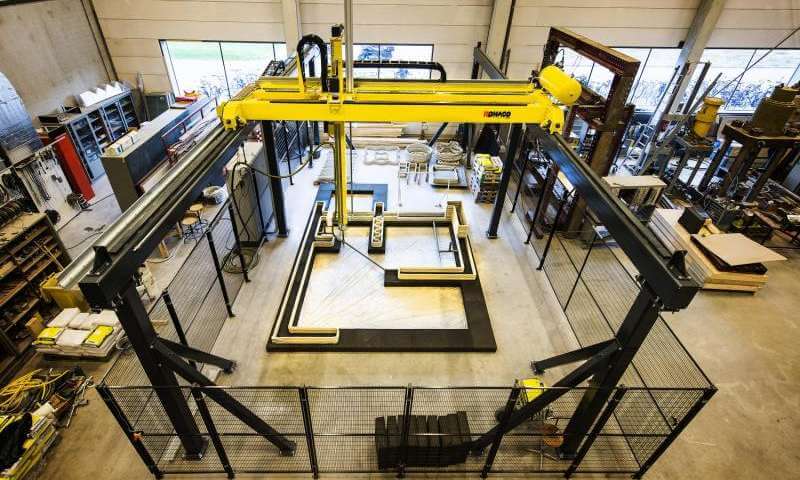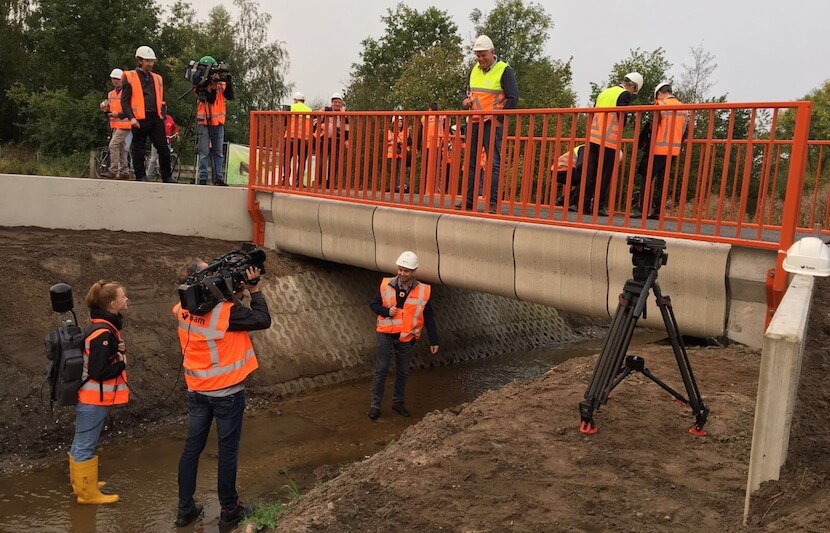Eindhoven University of Technology (TU/e) has printed the world’s first 3D-printed concrete bridge, which was recently installed as a part of a new road around the village of Gemert in the Netherlands.
The bridge is primarily meant for bicyclists. Since there are more bikes than people in the Netherlands, it is expected that hundreds of cyclists will ride over the 3D-printed bridge every day.
The new bridge is the first 3D-printed civil infrastructure project in the country. It is part of a large road construction project — the Noord-Om project — that was led by the company BAM Infra and commissioned by the province of North-Brabant.
Measuring 8 meters long and 3.5 meters wide, the bridge is designed to carry bicyclists for 30 years or more.
The structural integrity of the bridge was tested both in the lab as well as on location when a 5-ton weight was placed on it. That’s more weight than the bridge will ever actually carry.
The bridge’s elements were printed at TU/e, which performs high-end research on concrete printing.
TU/e began developing a giant concrete 3D printer as part of a large-scale research project in 2015.

T.A.M. (Theo) Salet, a professor of concrete structures at TU/e, said that the university’s goal is to make the 3D print process “robust and repeatable” so the entire process is seamless from design to printing. The process, he explained, uses an open system in which the robot reads the drawing, prints and corrects all that is needed.
The university also aims to “define test methods for printed concrete to make codes” and to “realize structural applications like reinforcement,” he said.
Based on the research outcome, some of the university’s industrial partners came up with the idea to print the bridge eight months ago.
The TU/e researchers then developed a process to incorporate steel reinforcement cables while laying a strip of concrete. The cable is the equivalent of the reinforcement mesh used in conventional concrete, which handles the stress from tension.
Once the process was developed, the actual printing was done in two weeks, said Salet.
“We had to deliver in time since it is part of a real project,” he said.
“Luckily and with support of a lot of students and industry we managed. It is for this reason we kept the design simple. Expect more exciting shapes soon.”
Benefits of 3D printing
One of the main advantages of 3D printing concrete is that it uses much less concrete than the conventional technique, which uses a mold. The printer only deposits concrete where it is needed, which decreases the use of cement. Cement production has a very high carbon footprint, but the new method reduces CO2 emissions.
Another benefit is versatility — the printer can make any desired shape, whereas conventional concrete shapes made from molds tend to be unwieldy in shape.
Concrete printing is also much faster. No formwork structures have to be built, and reinforcement mesh does not have to be put in place separately.
Overall, researchers think the realization will eventually be roughly three times faster than conventional concrete techniques.
What’s next for TU/e?
The team has also “printed a pavilion, some architectural elements like a bench and a wall, a vault by means of shell elements that we assembled afterwards,” said Salet.
Salet and his team are now working on five real houses in the Netherlands that “will be realized” soon, he said.
“However, the focus was so far on the development of knowledge,” said Salet.
“An interesting achievement is the option to reinforce the printed concrete immediately during the print process. We used the device to reinforce the bridge in the transverse direction. Longitudinally, it is prestressed.”
With the knowledge the researchers gained in this project, they are now able to design even larger concrete structures.
BAM plans to have the 3D concrete printer at construction sites from now on, which would eliminate the necessity of having to transport 3D printed pieces to sites and assemble them there. The approach is to print elements that are assembled afterwards, otherwise the maximum size of the structure would be limited by the size of the printer.
“3D concrete printing is still a journey with destination unknown,” said Salet.
“I hope students around the globe will travel together on this journey and inspire each other to explore the unknown and share their dreams to apply new technologies to realize smart and sustainable cities. Create appealing architecture, implement the idea of digital design and digital construction to reduce failure costs, think about making concrete structures part of the IoT (Internet of Things), limit the material needs and eventually start thinking on the material formally known as concrete.”



